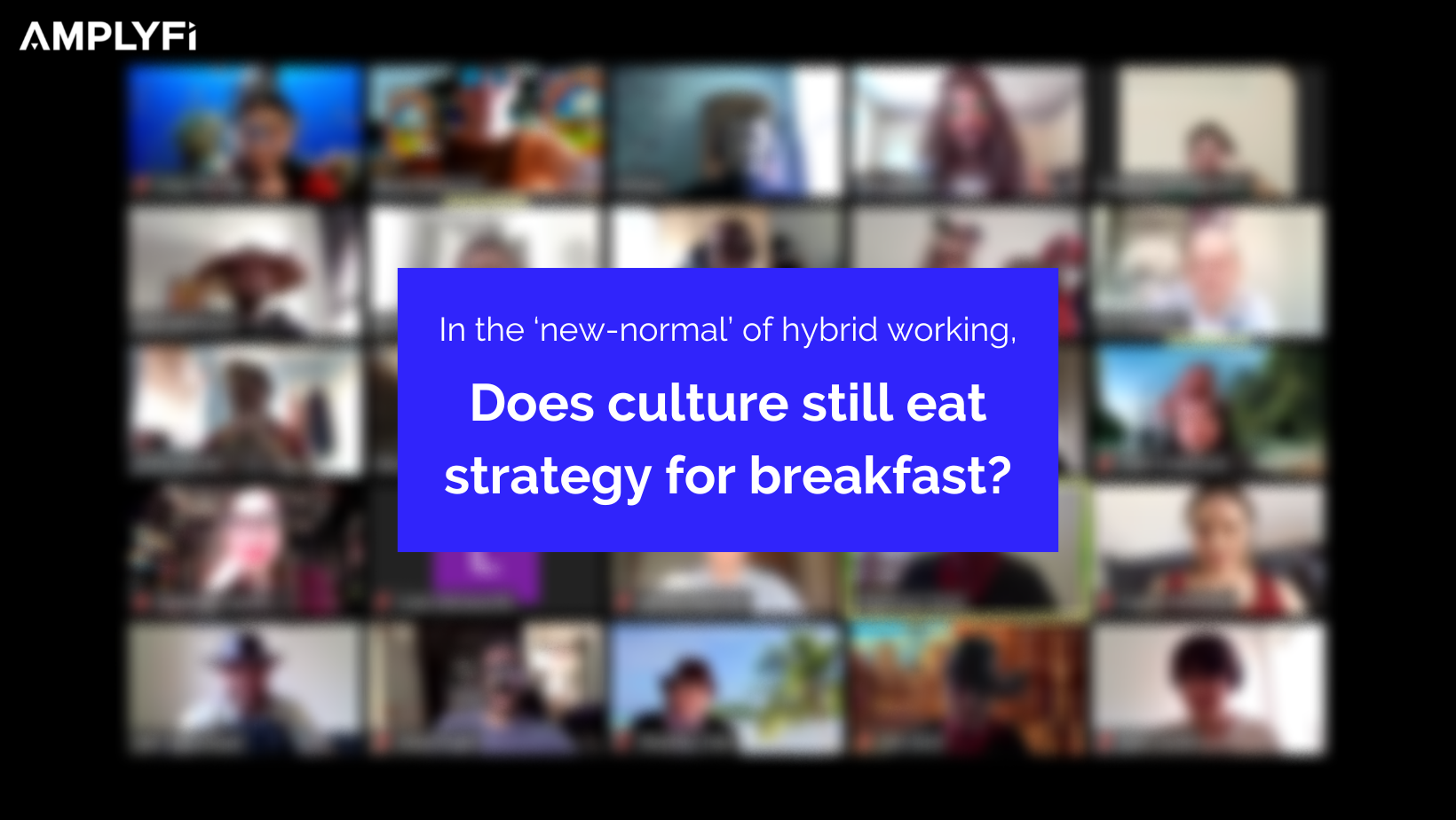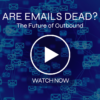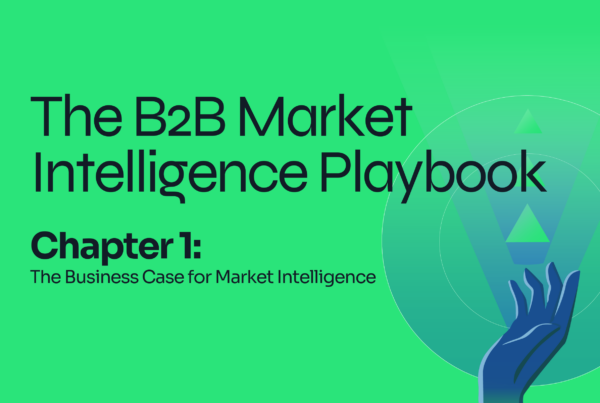
Rony Seamons is the Chief People Officer at AMPLYFI. Having spent years helping businesses to grow and scale, he joined AMPLYFI in 2018 just as the scaling journey began and has held a number of operational roles within the business. He now finds himself in the place he loves the most – working with talented people.
Legendary management consultant and business guru Peter Drucker is famous for coining the phrase ‘culture eats strategy for breakfast’. His intention was not to diminish the importance of strategy at all, instead he simply implied that its efficacy would be hugely impaired if there wasn’t a strong company culture to help deliver the business objectives. This phrase and sentiment was first mentioned in the 90s and has held strong for decades, but since the pandemic and the whole world mobilising to a new hybrid way of working, does this still hold true? Does company culture have as much impact in a hybrid working world as it did in the largely office-based pre-covid world? Read on to hear my views on the journey we’ve been on as a business.
Pre-Covid World
AMPLYFI started out very much as an office-based business. We all came to the office everyday to work, with only the odd work-from-home (WFH) day permitted, but not really encouraged. Back then, ‘shirk from home’ was perhaps the underlying sentiment on remote working, and presenteeism certainly played a part in the perception of how hard someone worked. We knew this was an outdated view of the workplace, but old habits die hard, and given the backgrounds most of us had come from i.e. large organisations with very traditional working models, we’d fallen into the trap of sticking to what we knew.
However, having us all together in the office on a daily basis meant we forged really strong relationships by getting to know each other so well – those incidental coffee chats about the weekend or going to Brewdog for Wings Wednesday – these were the unwritten, informal activities that help to bond people together. It also allowed us to have quite spontaneous gatherings and celebrations, something we all enjoyed as a group. It did however create a bit of an us-and-them feeling between our separate offices – Cardiff was seen as the HQ, and often whole team meetings involved everyone gathering around sofas in the Cardiff office with team members from other offices dialling-in using make-shift VC equipment. This was not ideal from a practical perspective, and not particularly inclusive for those not at the meeting in person. We’d been given this feedback in a few team surveys, but the impetus to change was low at that point – the COVID-19 pandemic would change all of that, and from an inclusion perspective, in our experience, almost certainly for the better (please don’t think for a second I see the pandemic as a good thing – I’m keenly aware how devastating this has been to millions of people across the globe, and we’ve all been affected by it).
The same was true of our engagements with customers – Zoom, our primary video conferencing platform at the time, was really in its infancy and the norm was still to arrange face-to-face (F2F) meetings as this was seen as the best way to forge relationships and ultimately make sales. We didn’t really know, or feel the need to explore any alternatives at that time and so custom and practice set in which seemed to work for our customers as much as it did for us.
I think it’s fair to say during this period we still felt we had a strong company culture, but because this was something we could almost see and feel on a daily basis we never felt the need to measure this in an objective and consistent way. The office was full daily, people were at their desks for long hours, we were hitting our business objectives, lots of socials were arranged and our retention was pretty good – so all things considered we were pretty happy.
Bringing this back to the original question in this piece, at this time in the business I’d say Mr Drucker was absolutely right and culture was a huge driving force in the success of the business. However, there were no major drivers for change and so the status quo remained.
During Covid
Due to the nature of our business (AMPLYFI’s platform uses AI to analyse content and uncover previously hidden trends and opportunities), we were in the fortunate position to be able to track the early signals of the pandemic and see the impact it could potentially have. As a result we started making early contingency plans for what a lockdown might look like and what changes we’d need to make. This was an incredibly scary time for everyone, and it was imperative we kept the company informed of what plans we were making. We set up a trial remote-working day for the entire business about 3 weeks before the full UK national lockdown, just to gain assurance we had everything in place to operate as a business should a lockdown happen. The trial was a complete success, and while we were now confident we could continue to operate effectively as a business, we had no idea what elements of the business might be affected by the move to being fully remote. It was one giant experiment, and we just afforded ourselves the time to see how things like welfare, communication, productivity and other cultural elements of the business would be affected over time. One thing we intentionally set out to do at the very beginning of the pandemic was to over-communicate – we used Slack for daily updates and had weekly all-hands calls to ensure everyone felt connected to the business during this time of huge uncertainty.

The AMPLYFI team at a fancy dress all-hands meeting
For me and many others this was a huge period of adjustment – I’d built my entire career based on being able to observe and interact with team members in person, and had limited experience in fostering and maintaining relationships and culture in a remote working environment. I’d no longer be able to ‘walk the floor’ and see if colleagues were having a good or bad day, and it made me think much more purposefully about how we as a business would capture this kind of feedback in alternative but equally effective ways.
Sadly the pandemic affected the entire planet, which meant the entire world was in the same boat and had to adjust our lives accordingly. In some ways, this was a galvanising force for us – the need to really look out for each other and check-in was certainly magnified during the first few months of Covid, and as a consequence I think we were able to retain a closeness even though it was all through the magic of Zoom! We were able to migrate all of our in-person practices online, and I was so proud of how well our team seamlessly moved to being a fully remote business. Stand-ups, 1:1s and all-hands meetings were all now conducted online – so in practical terms we could carry on with business as usual. One of the positive side-effects of this transition was that communication became much more inclusive and equitable. It no longer mattered where in the world you were based, you received all the business critical information at the same time as everyone else, and so in many ways the change was a great leveller for our global team from a communication perspective. And one thing was absolutely clear during these periods of lockdown – a strong culture helped us keep the business on track despite us all going through the biggest global turmoil of a generation. Having a team that remained connected and committed to the business, and who looked out for each other, meant we continued to meet our business objectives and drive the business forward.
One of the things we did introduce at this time was a means of measuring employee engagement. We introduced a variation of the Gallup Q12 survey, a widely recognised set of questions that help an organisation objectively measure employee engagement. We tried it for the first time in September 2021 and were delighted to get a score of 86% (very much in the ‘promoter’ score if you know your Net Promoter Score!).
I’ve also reflected a lot on this period, and often wondered how successfully we could have made this transition to a fully remote business had we not all been experiencing the pandemic. It didn’t matter if you were in Swansea, London, Santa Fe or Taipei, the pandemic meant we were all cocooned in our homes for long periods of time. How different would things have been had all our liberties not been taken away? Alas, this thinking is purely academic as there’s no doubt Covid happened in a big way and affected each and every one of us.
Post-Covid
So here we are back to today, and thankfully due to a global vaccination roll-out we’re getting closer to the freedom of movement we enjoyed pre-pandemic. We operate a truly hybrid working model, giving our talented team the choice to choose where they feel they can carry out the tasks required to achieve our goals best. We still operate a remote-first model for all our company wide comms, and travel remains at a hugely reduced level compared to pre-pandemic, both a result of the pandemic and our focus on our business’ environmental impact. We have large chunks of the business working from home on a regular basis which we all see as a privilege, but we also cherish the times we get to spend together in person. We no longer try to play the merits of F2F against remote, and simply look to maximise the benefits of both. Our culture remains something we are fiercely proud of, and given the continued uncertain economic times ahead, I have no doubt this will help us to drive the business forward.
Mr Drucker, it’s now over 30 years since you coined your famous phrase, and I say to you – in my humble opinion it’s as true now as it was then. Culture is still without doubt the glue that binds a company and the team together, and as people are still the fundamental drivers of success in any business, then culture will continue to play a pivotal role in any successful business. Long may we continue to truly see our people as our business’ greatest driving force, and to treasure the times we get to work and play together – whether that be in the office, at the park, in the pub or on a video call!
If I was culture, I know what I’d be having for breakfast tomorrow…








